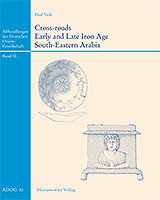Publication of Excavation Findings from the Iron Age in South-Eastern Arabia
6 June 2014

A new publication by Heidelberg University archaeologist Prof. Dr. Paul Yule focuses on the Iron Age in South-Eastern Arabia. In it, the scholar, who works at the Department of Languages and Cultures of the Near East, has assembled the findings accruing from his decades of research in the Sultanate of Oman and the United Arab Emirates and updated these findings with his latest discoveries. In the focus of interest are burial sites from the early and late Iron Age providing insights on the pre-Islamic centuries around the turn of the first millennium AD. The book is in English and contains almost 300 drawings and 23 colour photos of finds from excavations and archaeological sites.
The term Iron Age is used by experts to designate the era in which iron weapons and tools were widely used. As Prof. Yule explains, in south-eastern Arabia the period between 1300 and 300 BC is referred to as the early Iron Age, while the late Iron Age extends to 300 AD. “However, it was only a few years ago that iron from early Iron Age contexts was actually discovered by these excavations,” Prof. Yule says. “This is documented in the new publication as well.”
Prof. Yule began his archaeological research in Oman in 1982. His new book supplements a detailed and extensive excavation report from 2001 documenting his investigations of pre-Islamic burial sites in central Oman. “From an historical and archaeological point of view this region is perhaps the least well-known one in Arabia,” Prof. Yule points out. “Although plenty of research has been done on the early Iron Age in south-eastern Arabia, it is still an era that is difficult to fathom because the excavation sites are poorly preserved and the experimental investigation methods are frequently defective.” Accordingly, Prof. Yule’s new book contains re-evaluations of his excavation findings. In addition he speculates on the development of language in the era in question: “With reference to place names, it is quite conceivable that although today Arabic is spoken in most of the area, another Semitic language may well have predominated in the period we are talking about.”
The publication “Cross-roads – Early and Late Iron Age South-eastern Arabia” is angled at scholars and students alike. Alongside the illustrations it contains maps of the excavation sites discussed and an extensive glossary.
Reference:
Paul Yule: Cross-roads – Early and Late Iron Age South-eastern Arabia, Abhandlungen Deutsch-Orientalische Gesellschaft, vol. 30, Wiesbaden 2014

